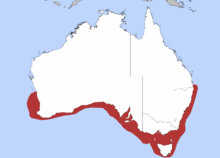Gummy shark
| Gummy shark | |
|---|---|
 | |
| Gummy Shark caught in Hastings, Western Point, Victoria | |
| Scientific classification | |
| Kingdom: | Animalia |
| Phylum: | Chordata |
| Class: | Chondrichthyes |
| Order: | Carcharhiniformes |
| Family: | Triakidae |
| Genus: | Mustelus |
| Species: | M. antarcticus |
| Binomial name | |
| Mustelus antarcticus Günther, 1870 | |
 | |
| Common distribution for flake in southern Australia | |
The gummy shark (Mustelus antarcticus), also known as the Australian smooth hound, flake, Sweet William or smooth dog-shark, is a shark in the Triakidae family. These small to medium size bottom-dwelling sharks are found mostly but not limited to the area around the southern seas of Australia is commonly baited and fished for cuisine because of its taste and market prices.
Appearance
This species is a slender, light grey shark with white spots along the top and side of its body gets its name from its flat, plate-like teeth for crushing its shelled and non-shelled prey. It feeds on crustaceans, marine worms, small fish and cephalopods such as octopus, squid, cuttlefish, etc.[1] Compared to the world’s largest fish, the whale shark, more formally known as the Rhincodon typus, which reaches maximum lengths of up to 12 meters long, the gummy shark can reach a maximum length of 157 cm for males and 175 cm for female. That makes this species of shark about 14 percent of the size of the whale shark. The minimum size for both male and female is 45 cm measured from the rear-most gill slit to the base of the tail fin. At birth, these sharks measure between 30 and 35 cm.[1]
Reproductive tendencies
Gummy sharks are found to be mostly bottom dwellers in the waters around southern Australia, from Shark Bay in Western Australia to Port Stephens in New South Wales, from the surface down to a depth of 350 meters in moderate temperature water. The reproduction of the single sex school gummy sharks is ovoviviparous.[2] Ovoviviparous organisms are those who produce young via egg and hatched inside of the parent’s bodies. A common example of an ovoviviparous being is a seahorse. Females can have up to 57 pups per litter and are ready to do so by the age of five.[3] The average number of pups per liter birthed by the female Mustelus antarcticus is 14 but can have up to 57.[1][3] Male sharks are ready to reproduce by the age of four. Gestation takes approximately one year. The typical generation length for the gummy shark is 10 years and have an average life expectancy of 16 years. These sharks pose no known threat to beach goers or fisherman. This species is also of least concern in terms of endangerment according to the IUCN Red List is an extensive list of species and where they fall on the endangered scale from “Least concern” (LC) to “Extinct” (EX).[3]
Fishing and consumption
Gummy shark meat is often marketed as "flake" in southern Australia. Their boneless fillets have made them particularly popular within the fish and chip industry throughout Australia.[1]Although gummy sharks have not been over fished, they inhabit many of the same areas as school (snapper) sharks which have an established bycatch quota. This means fishers targeting gummy shark cannot have an adverse impact on the school shark population.[2] According to SharkSmart, roughly one hundred gummy sharks are tagged with “internal acoustic tags” in Western Australia to yield information about possible migration and travel habits.[1]
Bag limits for recreational fishers in Victoria, Australia apply. Bag limits are laws placed on fisherman and hunters to limit the number of specific species they are allowed to catch, kill and/or keep. Fishermen have both a bag and a possession limit of two shark and/or school shark, landed whole or as a carcass. There is a 5 shark limit for large boats. If caught these sharks must be released if it is in total no larger than 75 cm or roughly two and a half feet.[4]
See also
References
- 1 2 3 4 "Sharksmart - Keep enjoying the beach". Sharksmart. Retrieved 2018-03-29.
- ↑ "Gummy Shark". "OCEAN TREASURES" Memorial Library. 2014-09-18. Retrieved 2018-03-29.
- 1 2 3 "Mustelus antarcticus (Gummy Shark, Sweet William)". www.iucnredlist.org. Retrieved 2018-03-29.
- ↑ "Gummy Shark". dpipwe.tas.gov.au. Retrieved 2018-03-29.
- Walker, T.I. (SSG Australia & Oceania Regional Workshop, March 2003) (2003). "Mustelus antarcticus". IUCN Red List of Threatened Species. Version 2013.2. International Union for Conservation of Nature. Retrieved 23 May 2014. Database entry includes justification for why this species is of least concern
- "Mustelus antarcticus". Integrated Taxonomic Information System. Retrieved 18 April 2006.
- Froese, Rainer and Pauly, Daniel, eds. (2005). "Mustelus antarcticus" in FishBase. November 2005 version.
- Edgar, Graham J. Australian Marine Life : The Plants and Animals of Temperate Waters. Reed New Holland, 2003.
